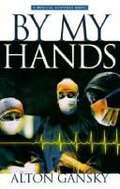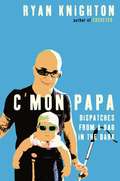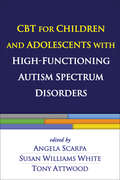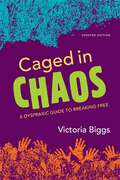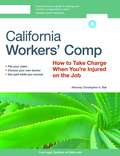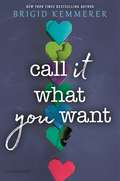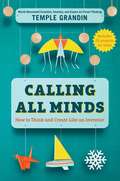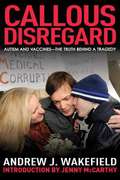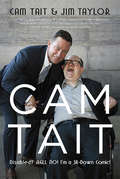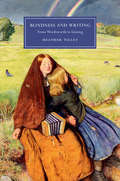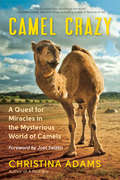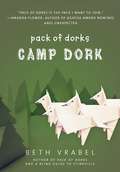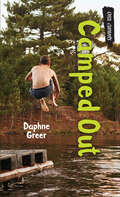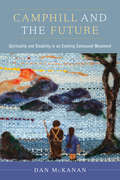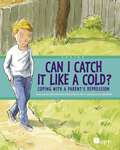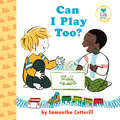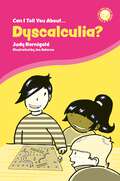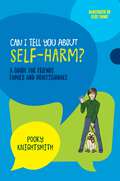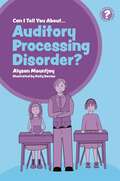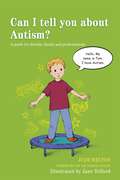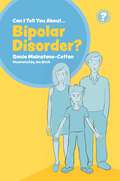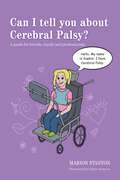- Table View
- List View
By My Hands
by Alton L. GanskySomething strange is happening at Kingston Memorial Hospital, and Dr. Rachel Tremaine has been ordered to get to the bottom of it. All she has to go on is the Fact that several patients have been healed--completely, and without medical intervention! While others may consider it "miraculous," Rachel's highly trained, scientific mind is unwilling to concede that. And the hospital wants answers--believable answers! When one of Rev. Adam Bridger's parishioners is suddenly healed-- and subsequently disappears--he launches his own investigation. Who is behind these mysterious healings, and why do the healed patients all seem to vanish? Is this an act of God or an incredible hoax? Rachel and Adam make the most unlikely of teams. But though they have little in common, they both have a lot of questions-- especially when it comes to miracles. And the search for answers may be far more dangerous than either is prepared for.
By Trust Betrayed: Patients, Physicians, and the License to Kill in the Third Reich
by Hugh G. GallagherIn September of 1939, immediately after he started World War II by sending an invading army into Poland, Adolf Hitler signed an order declaring war on his fellow German citizens-- that is, those of his fellow citizens who were crippled, mentally ill, or disabled. The directive was given to two of Hitler's closest associates, Dr. Karl Brandt, his personal physician, and Reichsleiter Philip Bouhler, the chief of his chancellery. They were to set up a program that enabled German physicians to kill anyone deemed "unworthy of life." Under the influence of the then-fashionable apocalyptic theories of eugenics, many German doctors greeted this blood-chilling idea as a "technological breakthrough" and an example of the new regime's advanced thinking, while the majority simply accepted it without protest. Despite this acceptance, and a barrage of propaganda in books, movies, newspapers, and magazines attempting to justify euthanasia, public outrage began to grow. Because of the resistance of brave disabled people and because of the public sermons of important clergy, including Clemens von Galen, the Bishop of Munster, Hitler rescinded his official order, suffering the only major policy reversal of his twelve years in power. Despite the absence of an official order, however, the doctors who had been authorized to kill continued to do so without any fear of reprisal or prosecution. More than 200,000 people were killed under the program throughout the war and even, in some cases, during the occupation that followed the war.
C'mon Papa: Dispatches from a Dad in the Dark
by Ryan Knighton<P>Ryan Knighton's humorous and perceptive tales of fatherhood take us inside an unusual new family, one bound by its father's particular darkness and light. <P>C'mon Papa is Ryan Knighton's heartbreaking and hilarious voyage through the first year of fatherhood. Becoming a father is a stressful, daunting rite of passage to be sure, but for a blind father, the fears are unimaginably heightened. Ryan will have to find novel ways to adapt to nearly every aspect of parenting: the most basic skills are nearly impossible to contemplate, let alone master. And how will Ryan get to know this pre-verbal bundle of coos and burps when he can't see her smile, or look into her eyes for hints of the person to come? But this is no pity party, and Ryan has no time for sentimentality. <P>Tackling these hurdles with grace and humour, Ryan is determined to do his part -- and this is where the fun starts. From holding his daughter as she wails into the night to their first nerve-wracking walk to the cafe, no activity between father and daughter is without its pitfalls. In his struggle to "see" Tess, Ryan reimagines the relationship between father and child during that first chaotic year.
CBT for Children and Adolescents with High-Functioning Autism Spectrum Disorders
by Tony Attwood Susan Williams White Angela ScarpaThis book helps clinicians harness the benefits of cognitive-behavioral therapy (CBT) for children and adolescents with high-functioning autism spectrum disorders (ASD). Leading treatment developers describe promising approaches for treating common challenges faced by young people with ASD--anxiety and behavior problems, social competence issues, and adolescent concerns around sexuality and intimacy. Chapters present session-by-session overviews of each intervention program, review its evidence base, and address practical considerations in treatment. The book also discusses general issues in adapting CBT for this population and provides a helpful framework for assessment and case conceptualization informed by DSM-5.
CVI Companion Guide to the Developmental Guidelines for Infants with Visual Impairments: A Guidebook for Early Intervention (2nd ed.)
by Amanda Hall Lueck Deborah Chen Elizabeth S. HartmannEver wonder how a brain injury might impact vision? From navigating in a crowd, avoiding eye contact, the inability to identify faces, or seeming to have an exaggerated emotional response when faced with an overload of visual stimuli, the CVI Companion Guide assists parents and service providers in navigating current research regarding the impact of brain injury and how it may impact visual processing, social interaction, and more. The book also delves into documenting a child’s current level of functioning with their CVI diagnosis and organizing a plan to work on skills needed to function in everyday activities. According to the text, “Five domains are presented in this Companion Guide: social-emotional, communication, cognitive, fine motor, and gross motor. The guide covers relevant research, key considerations, and intervention suggestions. In addition, potential behavioral outcomes of CVI are highlighted in a special section, and caregivers and practitioners are encouraged to infuse interventions within the context of daily routines that address these behaviors within each developmental domain. The Companion Guide is not an assessment tool, and no age expectations or developmental levels are provided because children with CVI are so varied in their expression of the condition.”
Caged in Chaos: A Dyspraxic Guide to Breaking Free Updated Edition
by Victoria Biggs Jo ToddWritten by a teenager with dyspraxia, this is a humorous and inspiring practical guide for young adults with dyspraxia and those around them trying to get to grips with the physical, social and psychological chaos caused by developmental co-ordination disorders (DCDs). In her own conversational style, Victoria Biggs explains the primary effects of dyspraxia - disorganization, clumsiness and poor short-term memory - as well as other difficulties that dyspraxic teenagers encounter, such as bullying and low self-esteem. Peppered with personal stories from other teens, this award-winning book offers down-to-earth advice on a wide range of adolescent issues, from puberty, health and hygiene to family life and making friends. The new edition includes an update from the author on her university and work experiences and how dyspraxia affects her now as an adult. Her positive approach and profound empathy with others in her situation make this book a must-read.
Calendars For Students With Multiple Impairments Including Deafblindness
by Robbie BlahaDeafblindness is a relatively rare condition in Texas. The children, families and staff are spread across 1,063 school districts. Since calendars are an essential part of instruction and intervention for students with deafblindness, it is important that families and support staff have access to information regarding calendar development and use. This resource guide is an attempt to organize existing information into a simple guide. I hope this guide makes it easier to design and implement the correct calendar in school, home and community settings for individuals with deafblindness.
California Workers' Comp: How to Take Charge When You're Injured on the Job
by Christopher BallMore than a million Californians a year suffer job-related injuries or illness. For many, receiving compensation can be a nightmare, since recent laws give employers and insurance companies far greater rights and employees fewer medical benefits. California Workers' Comp shows how to handle a California workers' compensation claim from start to finish. This plain-English guide, explains how to work with the insurance company to receive the medical treatment and benefits. Workers will find out how to: file a claim protect their legal rights receive the medical care they need get the benefits they're entitled to deal with uncooperative employers, doctors, and insurance agencies negotiate a settlement present their case before a judge This complete guide can help people handling their own claims or filing on a minor or other's behalf. This edition is completely updated to cover significant changes in the area of permanent disability ratings, along with recent updates to the Labor Code and other workers' comp laws. A comprehensive chapter is included for computer users with repetitive strain injuries.
Call It What You Want
by Brigid KemmererWhen his dad is caught embezzling funds from half the town, Rob goes from popular lacrosse player to social pariah. Even worse, his father's failed suicide attempt leaves Rob and his mother responsible for his care. Everyone thinks of Maegan as a typical overachiever, but she has a secret of her own after the pressure got to her last year. And when her sister comes home from college pregnant, keeping it from her parents might be more than she can handle. When Rob and Maegan are paired together for a calculus project, they're both reluctant to let anyone through the walls they've built. But when Maegan learns of Rob's plan to fix the damage caused by his father, it could ruin more than their fragile new friendship . . . In her compulsively readable storytelling, Brigid Kemmerer pens another captivating, heartfelt novel that asks the question: Is it okay to do something wrong for the right reasons?
Calling All Minds: How To Think and Create Like an Inventor
by Temple GrandinFrom world-renowned autism spokesperson, scientist, and inventor Temple Grandin -- a book of personal stories, inventions, and facts that will blow young inventors' minds and make them soar.Have you ever wondered what makes a kite fly or a boat float? Have you ever thought about why snowflakes are symmetrical, or why golf balls have dimples? Have you ever tried to make a kaleidoscope or build a pair of stilts? <p><p>In Calling All Minds, Temple Grandin explores the ideas behind all of those questions and more. She delves into the science behind inventions, the steps various people took to create and improve upon ideas as they evolved, and the ways in which young inventors can continue to think about and understand what it means to tinker, to fiddle, and to innovate. And laced throughout it all, Temple gives us glimpses into her own childhood tinkering, building, and inventing. <p>More than a blueprint for how to build things, in Calling All Minds Temple Grandin creates a blueprint for different ways to look at the world. And more than a call to action, she gives a call to imagination, and shows readers that there is truly no single way to approach any given problem--but that an open and inquisitive mind is always key. <P><b>A New York Times Bestseller</b>
Callous Disregard: Autism and Vaccines: The Truth Behind a Tragedy
by Jenny Mccarthy Andrew J. WakefieldAs Andrew Wakefield states in his prologue, "If autism does not affect your family now, it will. If something does not change--and change soon--this is almost a mathematical certainty. This book affects you also. It is not a parochial look at a trivial medical spat in the United Kingdom, but dispatches from the battlefront in a major confrontation--a struggle against compromise in medicine, corruption of science, and a real and present threat to children in the interests of policy and profit. It is a story of how 'the system' deals with dissent among its doctors and scientists." In the pursuit of possible links between childhood vaccines, intestinal inflammation, and neurologic injury in children, Wakefield lost his job in London's Royal Free Hospital, his country of birth, his career, and his medical license. A recent General Medical Council ruling stated that he was "dishonest, irresponsible and showed callous disregard for the distress and pain of children." Maligned by the medical establishment and mainstream media, Wakefield endeavors to set the record straight in Callous Disregard. While explaining what really happened, he calls out the organizations and individuals that are acting not for the sake of children affected by autism, but in their own self-interests.
Cam Tait
by Jim Taylor Cam Tait"I have cerebral palsy much like I have blue eyes and have-or should I say had?-brown hair. It is simply a part of who I am. When I speak to groups about my situation I can even joke about it. 'Think of CP as Canada Post,' I tell them. 'My brain sends out signals, and God knows where they wind up.'" Long-time journalist Cam Tait has seen some interesting times on the sports beat-rolling alongside Rick Hansen in the Man in Motion tour, playing in fundraising golf tournaments, and tipping back some cold ones with Wayne Gretzky, to name a few. His personal life hasn't lacked excitement either-memorable moments include parasailing, winning a stand-up (or in his case, sit-down) comedy contest, and helping his grandson take his first steps. But he couldn't have done it without the help of his friends. Tait was born with cerebral palsy, unable to sit up, speak or move his arms and legs. But thanks to a revolutionary form of physical therapy that required a 24/7 commitment from his parents and a team of 116 volunteers, he learned to get around in a wheelchair, move his hands and talk. These turned out to be useful skills for a career of prime interviews, crazy deadlines and pranks. Tait teams up with friend and fellow journalist Jim Taylor, telling his own story with characteristic directness and humour. With a newspaperman's inveterate sense of timing, Tait moves seamlessly from one-liners and tales of debauched hijinks to candid accounts of his depression, career struggles and loss of loved ones. He speaks with eloquence about the importance of giving disabled people the chance to pursue their ambitions, and the value of all the support he's received in achieving his own dreams. In both his career and personal life, he's experienced the power of humour to break down barriers and bring people together-and have a hell of a good time doing it.
Cambridge Studies in Nineteenth-Century Literature and Culture: From Wordsworth to Gissing (Cambridge Studies in Nineteenth-Century Literature and Culture #109)
by Heather Tilley<P>In this innovative and important study, Heather Tilley examines the huge shifts that took place in the experience and conceptualisation of blindness during the nineteenth century, and demonstrates how new writing technologies for blind people had transformative effects on literary culture. <P>Considering the ways in which visually-impaired people used textual means to shape their own identities, the book argues that blindness was also a significant trope through which writers reflected on the act of crafting literary form. <P>Supported by an illuminating range of archival material (including unpublished letters from Wordsworth's circle, early ophthalmologic texts, embossed books, and autobiographies) this is a rich account of blind people's experience, and reveals the close, and often surprising personal engagement that canonical writers had with visual impairment. <P>Drawing on the insights of disability studies and cultural phenomenology, Tilley highlights the importance of attending to embodied experience in the production and consumption of texts.
Camel Crazy: A Quest for Miracles in the Mysterious World of Camels
by Christina AdamsIn this page-turning odyssey, a mother on a mission travels the globe — from Bedouin camps in the Middle East to Amish farms in Pennsylvania to camel-herder villages in India — to obtain camel milk, which dramatically helps her son’s autism symptoms. Chronicling bureaucratic roadblocks, adventure-filled detours, and Christina Adams’s love-fueled determination, Camel Crazy explores why camels are cherished as family members and hailed as healers. Adams’s work uncovers studies of camel milk for possible treatment of autism, allergies, diabetes, and immune dysfunction, as well as ancient traditions of healing. But the most fascinating aspect of Adams’s discoveries is the gentle-eyed, mischievous camels themselves. Huge and often unpredictable, they are amazingly intelligent and adaptable. This moving and rollicking ode to “camel people” and the creatures they adore reveals the ways camels touch lives around the world. Includes users’ and buyers’ guides to camel’s milk
Camp Dork (Pack of Dorks #2)
by Beth VrabelThe pack of dorks heads to camp—and this time the bully they face might just be one of their own.Sheldon convinces Lucy, Sam, April, and Amanda to join him at Camp Paleo. Like cavemen, the campers are going to have to make do without air conditioning, and they'll dig for fossils during the day. And Grandma's coming too—as the lunch lady for the camp next door. But Sam backs out at the last minute to attend a gymnastics camp instead. Lucy wonders why she misses him so much—it's not like he's her boyfriend. Why does the word "boyfriend" make her blush? She needs a distraction. Enter Mr. Bosserman, the grouchy camp leader who won't budge on the camp's caveman theme. The old man needs some softening up, and Lucy knows just the person for the job: Grandma. One successful match made, Lucy starts to see potential lovebirds everywhere. But when the wrong campers pair up, the pack falls apart, all under the watchful eye of a secret blogger who's been writing about the camp's activities. Even worse? A thief is targeting everyone but Lucy, setting her up to look guilty. Soon Lucy finds herself alone, left to fix the messes she's made. If she fails, the pack may be splintered for good.
Camped Out (Orca Currents)
by Daphne GreerMax knows his mom can't afford to send him to summer camp. But he really, really wants to go. He needs a break from looking after his autistic brother, Duncan. And from his mom's new boyfriend. He is surprised when his mom says that he can go after all. But there's a catch. There are spots available at the camp for families with special needs. A grant would cover Duncan's fees, and Max could attend at no charge. If he goes as Duncan's escort. This is the second story featuring Max and Duncan after Maxed Out.
Camphill and the Future: Spirituality and Disability in an Evolving Communal Movement
by Dan McKananA free open access ebook is available upon publication. Learn more at www.luminosoa.org. The Camphill movement, one of the world’s largest and most enduring networks of intentional communities, deserves both recognition and study. Founded in Scotland at the beginning of the Second World War, Camphill communities still thrive today, encompassing thousands of people living in more than one hundred twenty schools, villages, and urban neighborhoods on four continents. Camphillers of all abilities share daily work, family life, and festive celebrations with one another and their neighbors. Unlike movements that reject mainstream society, Camphill expressly seeks to be "a seed of social renewal" by evolving along with society to promote the full inclusion and empowerment of persons with disabilities, who comprise nearly half of their residents. In this multifaceted exploration of Camphill, Dan McKanan traces the complexities of the movement’s history, envisions its possible future, and invites ongoing dialogue between the fields of disability studies and communal studies.
Can I Catch It Like a Cold?: Coping With a Parent's Depression (Coping #1)
by Centre For Addiction And Mental HealthIn partnership with the Centre for Addiction and Mental Health (CAMH), Tundra is proud to launch an important series of books for children who have to cope with adult-sized problems. Young Alex’s father had been a policeman until he began to suffer from depression, perhaps the most common mental health issue we face. Alex’s questions are those that are often asked by the children of parents who have depression: is the parent simply lazy? Does he no longer care? And is it something I can catch, like a cold?In simple, straightforward language, the book explains what depression is and how it is treated. It also prepares a child for working with a helping professional. And perhaps most important, it reassures a child that he or she is not alone.Written by Canada’s foremost experts in the field, this is an important book to spur discussion and allay fears of those affected by depression.
Can I Play Too? (Little Senses)
by Samantha CotterillFriendship--and trains!--take center stage in this gentle, inviting story about paying attention to other people's feelings.Two boys' fun train-track-building project takes a turn when one of the boys obliviously insists on only doing things his way. Their disagreement spells disaster for the train and the friendship, until a kind teacher steps in and explains how to tell when a friend is feeling happy, frustrated, or angry. . . and how to ask for a do-over.Compromising and paying attention to how other people are feeling can be hard for any kid, but especially for kids on the autism spectrum. Samatha Cotterill's third book in the Little Senses series provides gentle guidance along with adorable illustrations to help every kid navigate the twists and turns of friendship and working together.
Can I Tell You About Dyscalculia?: A Guide for Friends, Family and Professionals (Can I tell you about...?)
by Judy HornigoldSam is a young boy with Dyscalculia, a lifelong condition that affects a person's ability to process numbers. It is now often compared to the way in which children with dyslexia struggle to process words. Written and illustrated from Sam's perspective, this is an excellent guide for helping children aged 7+ to understand and navigate Dyscalculia. Identifying signs, symptoms and co-occurence in child-friendly terms, Sam's story provides children with the reassurance and encouragement they need to seek help at home and at school. It also provides practical and powerful techniques for overcoming their symptoms, building self-confidence and achieving great success in life. For parents and teachers, it builds awareness around the profound and often crippling effect that Dyscalculia can have on various aspects of a child's day-to-day life, including their relationships with friends and family. It includes invaluable guidance on how to help at home and at school, as well as an extensive list of resources for those seeking additional support.
Can I Tell You About Self-Harm?: A Guide for Friends, Family and Professionals
by Pooky Knightsmith Elise Evans Jonathan SingerMeet Asher - a teenager who self-harms to manage their feelings when it all feels like too much. The latest in the best-selling Can I Tell You About... series describes what self-harm is, along with the wide range of behaviours that qualify, why teens do it, and how to get help if you feel the need to self-harm. Reflecting on the different aspects of self-harming behaviour, including treatment of injuries and scars, this concise introduction dispels common myths and offers helpful resources to break the cycle of self-harm. By initiating the conversation around self-harm, this guide will offer alternative avenues for children and young adults to pursue when dealing with big feelings, such as professional counselling, distraction, and friends and family. This easy-to-read guide is suitable for readers 7+, along with their parents, teachers, and friends. All author royalties from the book will go towards the Charlie Waller Memorial Trust.
Can I tell you about Auditory Processing Disorder?: A Guide for Friends, Family and Professionals (Can I tell you about...?)
by Alyson Mountjoy Kelly DaviesIn this friendly guide, a girl called Amy tells all about her Auditory Processing Disorder (APD). Together with her friend Tom and sister Lucy, Amy explains how every child with APD is affected in unique ways, and how to get help if you have APD. This illustrated guide is ideal for helping children aged 7+ with APD to understand the condition, while increasing their self-esteem and confidence. Explaining about causes, symptoms, diagnosis and comorbidity in child-friendly terms, it dispels myths and encourages children to self-advocate and seek help at home and at school. It is also an excellent starting point for parents, teachers and other professionals wishing to tailor support to the type and severity of a child's APD, and includes a helpful list of recommended sources for additional support.
Can I tell you about Autism?: A guide for friends, family and professionals
by Jude Welton Jane Telford Glenys JonesMeet Tom - a young boy with autism. Tom invites readers to learn about autism from his perspective, helping them to understand what it is and explaining the challenges he faces with issues such as social communication, sensory overload and changes in his routine. Tom tells readers about all the ways he can be helped and supported by those around him. This illustrated book is ideally suited for readers aged 7 and upwards, and will be an excellent way to increase understanding about autism, in the classroom or at home. It also includes clear, useful information for parents and professionals.
Can I tell you about Bipolar Disorder?: A Guide For Friends, Family And Professionals (Can I Tell You About... ? Ser.)
by Sonia Mainstone-Cotton Jon BirchIf a grownup you love has bipolar disorder, what does that mean? In this friendly guide, 11-year-old Josh tells all about his dad's bipolar, including what mental illness is, and how it can affect patients and their families. The guide explains in child-friendly terms how different types of bipolar affect people's feelings and behaviour. It is a comforting book that prepares young readers for the hard parts of knowing someone with bipolar, while communicating that bipolar is nothing to be afraid or ashamed of. Providing an excellent starting point for discussion both at home and in the classroom, it also includes a helpful list of recommended sources for additional support.
Can I tell you about Cerebral Palsy?: A guide for friends, family and professionals
by Marion Stanton Katie StantonMeet Sophie - a girl with cerebral palsy (CP). Sophie invites readers to learn about CP from her perspective, helping them to understand what it is like to use a wheelchair to move around and assistive technology to communicate. She also introduces readers to some of her friends who have different forms of CP and explains that living with CP can sometimes be difficult, but there are many ways she is supported so that she can lead a full and happy life. This illustrated book is ideal for young people aged 7 upwards, as well as parents, friends, teachers and professionals working with children with CP. It is also an excellent starting point for family and classroom discussions.
